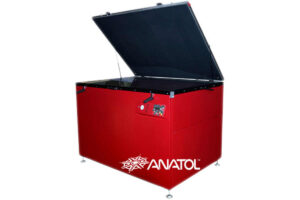

Revolucionando la industria de la serigrafía a través de tecnología de punta y servicio de calidad
Anatol Equipment Manufacturing Co.
1429 S Shields Dr
Waukegan, IL 60085


Revolucionando la industria de la serigrafía a través de tecnología de punta y servicio de calidad
Anatol Equipment Manufacturing Co.
1429 S Shields Dr
Waukegan, IL 60085

All exposure units work on the same principle: providing a source of UV light to cure the emulsion around your graphic so that you can produce a sturdy stencil. Exposure units vary widely, however, on how they produce that UV light. The different types of lighting used in the units determine the initial purchasing price of the unit, the exposure time and the maintenance costs associated with the unit, as well as the crispness of the stencil itself.
While many shops initially rely on fluorescent exposure units because of their low costs, shops looking to up their production and their efficiency eventually will look at a more powerful unit that produces crisper stencils faster. These days, that generally means choosing between a metal halide or an LED exposure unit. To choose the right exposure unit, you’ll need to understand the differences between the two types of exposure units and how they’ll affect your shop.
For years, metal halide exposure units were the best in the screen printing industry, and they still rank among the best screen exposure units. Metal halide exposure units use a high-wattage single-source bulb to quickly cure screens. Because they provide a single source of intense UV light, metal halide exposure units create stencils with crisp edges, so they’re ideal for producing screens for highly detailed print runs.

Anatol’s user friendly Metal Halide exposure unit is perfect
for producing crisp stencils with even, consistent exposure.
The primary downside to metal halide exposure units is cost, both in terms of the initial purchase and the cost of operation and upkeep. Metal halide bulbs take time to warm up, and turning the bulbs on and off causes them to burn out faster. Because of the high cost of bulbs — which can cost between $200 and $300 — and the warm-up time, some shops keep their exposure units running all day, which places a burden on the shop’s electrical usage. Metal halide bulbs do dim in intensity as they age, leading to longer exposure times, and it’s recommended that the bulbs are replaced every one to three years.
For the past few years, the popularity of LED exposure units has been growing. The UV light created in LED exposure units is created by light emitting diodes rather than traditional light bulbs. For screen printing exposure units, the diodes used are designed to create the perfect wavelength of UV light, which means emulsion can cure within a matter of seconds or a matter of minutes.
Anatol’s Aurora UV LED exposure unit will expose
your screens quickly, efficiently and with sharp detail.
LED exposure units offer an operational cost savings over metal halide units. The units take much less power to operate — an estimated one-fifth of the operating energy of metal halide units — and they require no warm-up time, which means they don’t have to be left running all day. LED exposure units don’t have bulbs that require regular replacement and the UV light produced doesn’t weaken over time.
There are some potential drawbacks to LED exposure units, however. Some in the screen printing industry believe that creating a crisp stencil requires a strong single point of UV light, like that created by a metal halide bulb. LED exposure units provide all over UV light. LED units also provide UV light at a very specific wavelength; some claim that a good cure requires a range of UV light. However, manufacturers maintain that there is not a noticeable difference in stencil crispness between LED and metal-halide exposure units.
Which exposure unit you select will depend on your shop’s needs. You’ll want to consider different options, such as vacuum suction to hold positives to the unit or vertical space-saving units. As you narrow down your choices, you can request to have some of your shop’s screens exposed on the units you’re considering so that you can compare the stencil and print quality. Whichever exposure unit you select — a metal halide or LED unit — if you’re upgrading from a fluorescent unit, you’ll see a marked improvement in your screen quality and your exposure efficiency.
You’ll also have to consider the size of the screens you’ll be exposing, not just now, but in the future too. If you’re thinking about upgrading your press sometime soon, you may need to expose larger screens than you’re currently using. Plan ahead so you choose equipment your shop can grow with.
Like any piece of equipment you’ll add to your screen printing shop, pay attention to the power requirements when selecting an exposure unit. Before you buy, make sure your shop can handle the additional electrical demands – some units require standard 110 volt power, others need 220. Without electricity, an exposure unit is nothing more than an expensive paperweight!
Whether you’re leaning towards metal halide or LED, we’ve got you covered. Need some help choosing the perfect exposure unit for your shop? Let’s figure it out together!
Looking for some tips on getting the best results from your exposure unit? Check out this blog post
Your message was successfully sent!